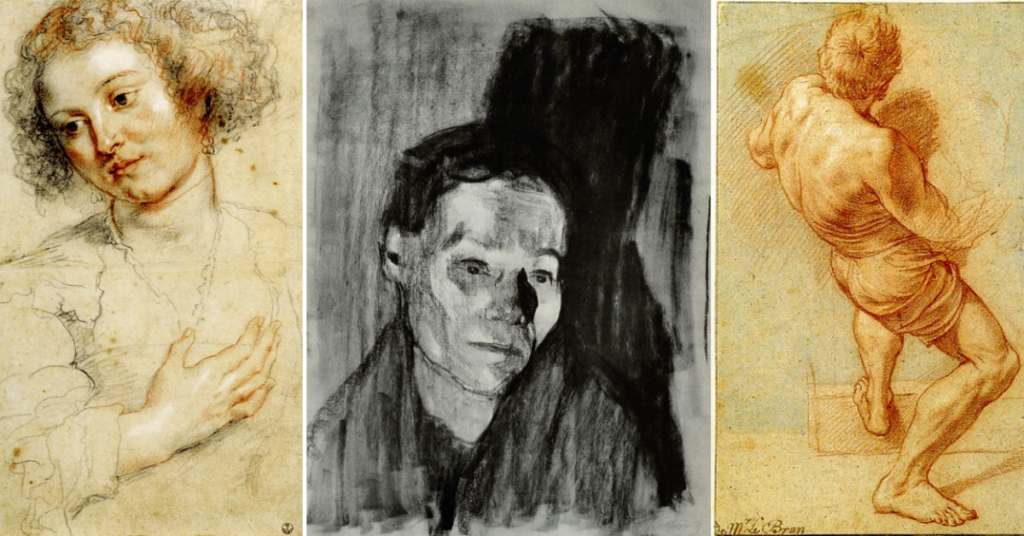Every masterpiece begins as an idea, often sketched on a humble piece of paper. These preliminary works give us a glimpse into the creative minds of great artists and the evolution of their most celebrated works. Here are some famous sketches that became masterpieces, showcasing the transformation from raw concept to iconic art.
1. Leonardo da Vinci – Vitruvian Man
Year: c. 1490
Medium: Pen and ink on paper
This iconic sketch is a study of the proportions of the human body, blending art and science. It represents da Vinci’s exploration of symmetry, anatomy, and the human form’s relationship to geometry.
How It Became a Masterpiece:
While the sketch itself is widely regarded as a masterpiece, it laid the groundwork for da Vinci’s other works, influencing his anatomical studies and Renaissance art as a whole.
2. Michelangelo – Studies for the Sistine Chapel Ceiling
Year: c. 1508–1512
Medium: Chalk and ink
Michelangelo’s preparatory sketches for the Sistine Chapel ceiling are remarkable artworks in their own right. These studies include detailed sketches of muscular figures and dynamic poses that later became part of the iconic fresco.
How It Became a Masterpiece:
The sketches allowed Michelangelo to experiment with composition and anatomy, resulting in the stunningly complex and dynamic figures that adorn the Sistine Chapel ceiling.
3. Pablo Picasso – Les Demoiselles d’Avignon Studies
Year: 1907
Medium: Pencil and charcoal
Before creating the groundbreaking Les Demoiselles d’Avignon, Picasso made numerous sketches and studies to refine his ideas. These sketches reveal his experimentation with form, composition, and abstraction.
How It Became a Masterpiece:
The sketches were a critical part of Picasso’s process in creating one of the first Cubist paintings, which revolutionized modern art.
4. Vincent van Gogh – Wheatfield with Crows Sketches
Year: 1890
Medium: Pencil and ink
Van Gogh’s sketches for Wheatfield with Crows capture the essence of the final painting, with its sweeping lines and dramatic composition. These preparatory works reflect his emotional state and artistic vision.
How It Became a Masterpiece:
The sketches laid the foundation for one of Van Gogh’s most poignant and expressive paintings, often interpreted as a reflection of his inner turmoil.

5. Claude Monet – Studies for Water Lilies
Year: 1899–1926
Medium: Pencil and watercolor
Monet’s iconic Water Lilies series was preceded by countless sketches and studies. These works helped him explore the interplay of light, water, and flora, which became central to his Impressionist style.
How It Became a Masterpiece:
The sketches guided Monet in creating his immersive and dreamlike depictions of his garden, which remain some of the most celebrated works in Impressionism.
6. Rembrandt – The Night Watch Studies
Year: c. 1642
Medium: Pen and ink
Rembrandt created several sketches and compositional studies for The Night Watch, testing different arrangements of figures and lighting effects. These preparatory works were vital in achieving the painting’s dramatic impact.
How It Became a Masterpiece:
The sketches enabled Rembrandt to perfect the dynamic composition and use of chiaroscuro, making The Night Watch a defining work of the Dutch Golden Age.
7. Salvador Dalí – The Persistence of Memory Studies
Year: 1931
Medium: Pencil and ink
Dalí’s preparatory sketches for The Persistence of Memory feature the iconic melting clocks and surreal landscapes. These studies reveal his thought process and refinement of surrealist concepts.
How It Became a Masterpiece:
The sketches allowed Dalí to experiment with surreal elements, resulting in one of the most recognizable works in modern art.
8. Georgia O’Keeffe – Jimson Weed Sketches
Year: 1936
Medium: Charcoal and pencil
O’Keeffe’s sketches of flowers were the foundation for her famous large-scale floral paintings. Her studies of Jimson Weed show her meticulous observation and exploration of form.
How It Became a Masterpiece:
The sketches helped O’Keeffe create her bold and vibrant paintings, which redefined floral art and established her as a pioneer of modernism.
9. Edgar Degas – Dancer Studies
Year: c. 1870s–1880s
Medium: Pastel and charcoal
Degas was known for his obsession with capturing movement, particularly in his studies of ballet dancers. His sketches feature dynamic poses and delicate lines that capture the grace and effort of the performers.
How It Became a Masterpiece:
The studies were integral to Degas’ famous paintings and sculptures of dancers, celebrated for their beauty and realism.
10. Katsushika Hokusai – Sketches for The Great Wave off Kanagawa
Year: c. 1830–1831
Medium: Ink on paper
Hokusai’s preparatory sketches for The Great Wave off Kanagawa illustrate his process of refining the composition and detailing the wave’s iconic form.
How It Became a Masterpiece:
The sketches helped Hokusai achieve the balance and drama that made The Great Wave one of the most iconic works in Japanese art.
Conclusion
These famous sketches highlight the importance of the creative process in producing masterpieces. They offer a rare glimpse into the minds of great artists, showing how ideas evolve and transform into enduring works of art.

